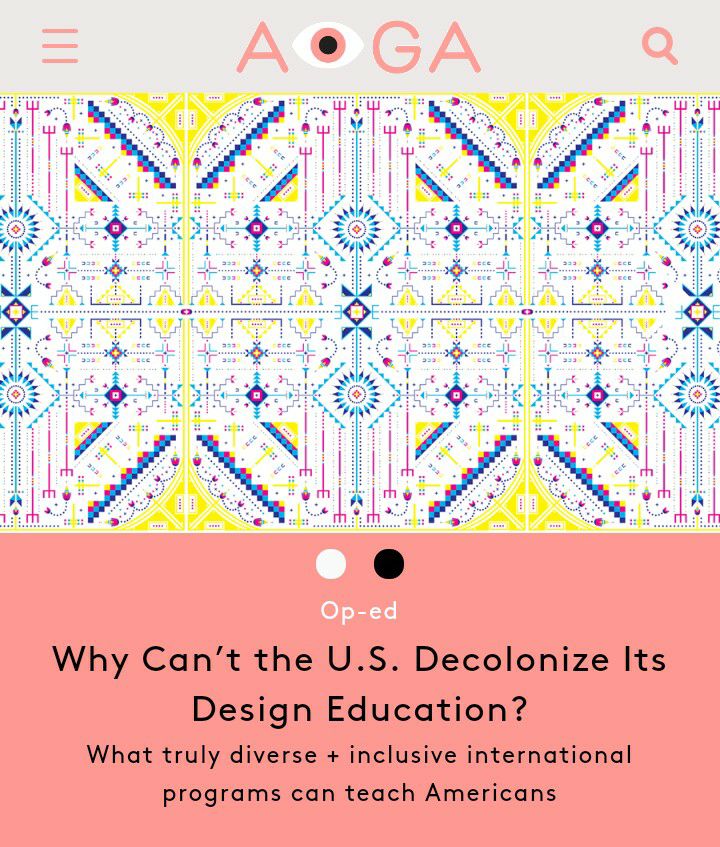
Back in October, I participated long-distance in the panel “Respectful Design: Decolonization as an Urgent Imperative” as part of the Culture of Criticism Symposium at the national AIGA Conference. Panel organizer Dori Tunstall, Lakota designer Sadie Red Wing, and I were co-creators of a video presented at the panel, and I was streamed in for the Q&A portion. After the conference, writer Margaret Andersen contacted Dori, Sadie, and me for an article she was writing for AIGA’s blog Eye on Design. Her op-ed, Why Can’t the U.S. Decolonize Its Design Education? What truly diverse + inclusive international programs can teach Americans brings attention to the need to include Indigenous visual cultures and voices in design curriculums. A big thanks to Margaret and AIGA for addressing this important subject and bringing it to a wider audience! Dori, Sadie, and I are all quoted in the article, and they included work by some of the designers I mentioned as well: Angel De Cora (1871-1919), Rico Worl, and Chad Earles. Sadie has some beautiful designs featured also. Check it out!
Given the limitations of space and scope, the article wasn’t able to include some of the comments I submitted, so I wanted to be sure to credit the important ways my design professors nurtured my education. Thank you for giving me the freedom to creatively and intellectually explore, which laid the foundation for the work I am doing today. Further comments are below:
Overall, my professors and instructors cared deeply about design and were dedicated to the education and creative development of the students, regardless of background. They emphasized a focus on conceptualization and critical thinking and pushed us to work hard and care about our work. Throughout the program, there was also a consistent thread of the importance of being socially responsible as designers. Through the art department’s visiting artist and scholar lecture series, I had the chance to meet two prominent, socially engaged designers — Luba Lukova and Yossi Lemel. The parameters of many of our class projects gave us room to pursue personal interests; several of my own design projects involved Native subject matter. While at Oregon State, I first began exploring the subject of design as it relates to Indigenous peoples. When I was working on my senior project, the teachers and other students didn’t necessarily have the background to give more involved feedback on what I was doing, but in general, they were supportive. Despite the competitive atmosphere of the design program, my classmates and I helped each other tremendously throughout our time together.
A problem that many schools have, including my alma mater, is that the educational foundation of art and design students overwhelmingly leans toward European art and design history and the work of white artists and designers. Typically, most centers of education in the Americas have Eurocentric curriculums. While most educators inherit this situation with absolutely no ill intent, the truth is, the situation is historically rooted in some very ugly things: white supremacism, genocide, displacement, cultural suppression, and forced assimilation. It’s important to acknowledge this truth and make changes where we can. My school did have a class on Native art history that was occasionally offered, but I would like to see Native histories more fundamentally included in higher education. We are living in the Americas. It’s absurd to leave out the histories, perspectives, and visual cultures of the many diverse groups of people that have been here for thousands of years.
Another subject that I think is important for design educators to explore further is the responsibility involved in using designs from another culture. In the creative industries, while pursuing inspiration, it’s very common to sample ideas and visuals. I know many balk at the subject of misappropriation out of fear of killing creativity, but I don’t think we need to be afraid. I think people could potentially explore designs from another culture, with the caveat that they make the effort to understand what they are using and have the willingness to step back when ethical issues arise. We have to be aware of how imbalances of power can be at play when an individual or group feels entitled to use the creative work of another. It’s important to acknowledge that indigenous peoples have their own legitimate design conventions, where symbols communicate more than just a pretty pattern. Even within a cultural group, members of that community may observe restrictions in the usage of particular imagery. Not everything is up for grabs. I frequently come across work that is a stereotypical notion of what people think Native art is. I’ve seen questionable “Native” design by both non-Native and Native people. It’s not good design to have misinformed work that isn’t actually communicating anything. If we as designers believe in the importance of content over style, we need to dig deeper. Developing cultural competency will lead to better, more informed work.
This is a really interesting article. I had never before considered how the educational institutions lean heavily toward European art. Now that you bring it up, it’s blatantly obvious but the though had just never occurred before. I for one would really like to see universities start to show a more diverse ciriculum in the arts but also across all subjects broadly. We should be educating our youth with as many possible world views as possible. End Rant! Thanks for sharing!
A great piece of information that you’ve here. It’s nice to see that you’re sharing such amazing post with us all. You’re raising a huge issue on the article here and we agree with you on your proven point.
Nice work keep it up.